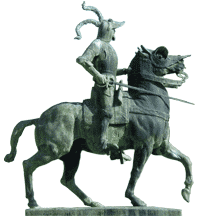The Last Days of the Incas’ Peru Tour #2 (Lima)
posted on May 22nd, 2008 in Incas, Lima, Peru, Peru, The Last Days of the Incas' Peru Tour
Lima (1 day) The Plaza de Armas, Francisco Pizarro’s Statue, Pizarro’s Remains, Cerro San Cristóbal
Most visitors spend little if any time in Lima, Peru’s capital of 10 million; it’s crowded, noisy, not visually dramatic, and is for a good part of the year (June through December) covered in a thin haze of garua, or fog. However, even a day spent there can be rewarding in terms of visiting some of the sites described in The Last Days of the Incas, and when the sun is out and you are eating a fine plate of ceviche (raw fish “cooked” in lemon juice) in a seaside restaurant, Lima can be a very pleasant place indeed.
Whereas the Lima coastal area was settled for thousands of years before the Incas conquered this area, the actual city of Lima was actually founded by Francisco Pizarro in 1535, shortly before the Incas rose up massively against his rule. It was here, in 1536, that the Inca Emperor Manco Inca’s finest general, Quiso, led an army against Pizarro and 100 of his Spaniards that nearly wiped out the last Spaniards in Peru. It was here, in 1541, that Pizarro was assassinated and it is still here, in the Cathedral on the Plaza de Armas, that Pizarro’s bones are kept in a crypt, more than four centuries after his assassination. They are still scarred by his assassins’ swords and daggers…
Interestingly, the only statue of Francisco Pizarro in all of Peru once stood in the Plaza de Armas, in downtown Lima. In 2003, after protests from indigenous groups, the city removed the offending statue as Pizarro, after all, had slaughtered thousands of natives, including the Inca emperor, and destroyed the Inca Empire. Pizarro’s statue is still located downtown, but is now in a more “discrete” location: it currently stands in The Park of the Wall, (Parque de la Muralla) behind the Monasterio de San Francisco, overlooking the Rimac River. The park has a restored section of the old wall that once surrounded Lima, The City of the Kings, and was originally constructed in the 17th century to protect the city from (English) pirates and other enemies of the crown. There is also a museum that displays archaeological excavations and artifacts found in this area.
The 14,000 pound bronze statue was created by the American sculptor Charles C. Rumsey (1879-1922), a flamboyant sculptor who studied at the Beaux-Arts in Paris, was a boxing champion in France, and an avid polo player. His widow donated a replica of the statue in 1927 to Pizarro’s hometown of Trujillo, Spain, where it now stands in Trujillo’s town square. A smaller replica is located in front of the Albright-Knox Art Gallery in Buffalo, New York.
(To be continued…)

